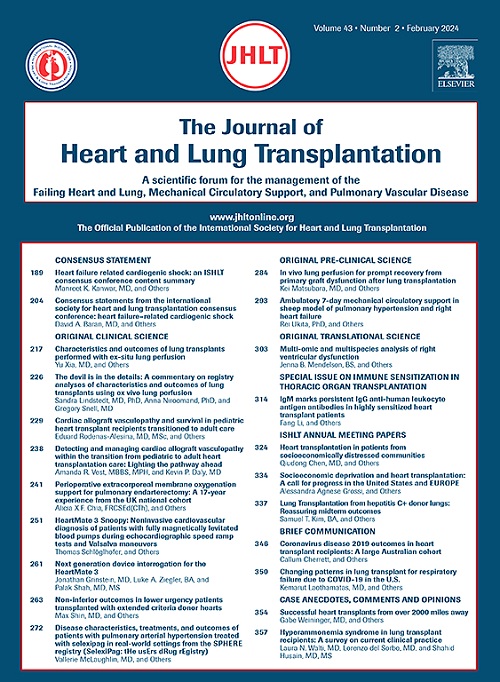Pollution exposure in the first 3 months post transplant is associated with lower baseline FEV1 and higher CLAD risk
IF 6
1区 医学
Q1 CARDIAC & CARDIOVASCULAR SYSTEMS
引用次数: 0
Abstract
Background
Exposure to air pollution post-lung transplant has been shown to decrease graft and patient survival. This study examines the impact of air pollution exposure in the first 3 months post-transplant on baseline (i.e., highest) forced expiratory volume in 1 second (FEV1) achieved and development of chronic lung allograft dysfunction (CLAD).
Methods
Double-lung transplant recipients (n = 82) were prospectively enrolled for comprehensive indoor and personal environmental monitoring at 6- and 12-week post transplant and followed for >4 years. Associations between clinical and exposure variables were investigated using an exposomics approach followed by analysis with a Cox proportional hazards model. Multivariable analyses were used to examine the impact of air pollution on baseline % predicted FEV1 (defined as the average of the 2 highest values post transplant) and risk of CLAD.
Results
Multivariable analysis revealed a significant inverse relationship between personal black carbon (BC) levels and baseline % FEV1. The multivariable model indicated that patients with higher-than-median exposure to BC (>350 ng/m3) attained a baseline % FEV1 that was 8.8% lower than those with lower-than-median BC exposure (p = 0.019). Cox proportional hazards model analysis revealed that patients with high personal BC exposure had a 2.4 times higher hazard risk for CLAD than patients with low BC exposure (p = 0.045).
Conclusions
Higher personal BC levels during the first 3 months post-transplant decrease baseline FEV1 and double the risk of CLAD. Strategies to reduce BC exposure early following a lung transplant may help improve lung function and long-term outcomes.
移植后最初 3 个月的污染暴露与较低的基线 FEV1 和较高的 CLAD 风险有关。
背景:肺移植后暴露于空气污染会降低移植物和患者的存活率。本研究探讨了移植后前 3 个月暴露于空气污染对基线(即最高)1 秒用力呼气容积(FEV1)和慢性肺移植功能障碍(CLAD)发展的影响:方法:对双肺移植受者(82 人)进行前瞻性登记,在移植后 6 周和 12 周进行全面的室内和个人环境监测,并随访 4 年以上。临床变量与暴露变量之间的关联采用暴露组学方法进行研究,然后采用 Cox 比例危害模型进行分析。多变量分析用于研究空气污染对基线预测 FEV1%(定义为移植后达到的两个最高值的平均值)和 CLAD 风险的影响:结果:多变量分析显示,个人黑碳(BC)水平与基线预测 FEV1 百分比之间存在显著的反向关系。多变量模型显示,BC暴露量高于中位数(>350纳克/立方米)的患者的基线FEV1%比BC暴露量低于中位数的患者低8.8%(p = 0.019)。Cox比例危险模型分析显示,个人BC暴露量高的患者发生CLAD的危险风险是BC暴露量低的患者的2.4倍(p = 0.045):结论:移植后前 3 个月内个人 BC 水平较高会降低基线 FEV1,并使 CLAD 风险增加一倍。肺移植术后早期减少 BC 暴露的策略可能有助于改善肺功能和长期预后。
本文章由计算机程序翻译,如有差异,请以英文原文为准。
求助全文
约1分钟内获得全文
求助全文
来源期刊
CiteScore
10.10
自引率
6.70%
发文量
1667
审稿时长
69 days
期刊介绍:
The Journal of Heart and Lung Transplantation, the official publication of the International Society for Heart and Lung Transplantation, brings readers essential scholarly and timely information in the field of cardio-pulmonary transplantation, mechanical and biological support of the failing heart, advanced lung disease (including pulmonary vascular disease) and cell replacement therapy. Importantly, the journal also serves as a medium of communication of pre-clinical sciences in all these rapidly expanding areas.

 求助内容:
求助内容: 应助结果提醒方式:
应助结果提醒方式:


